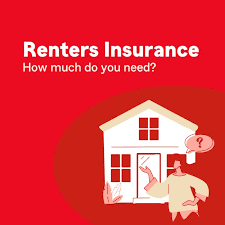Renters insurance typically includes three main components:
-
Personal Property Coverage – Protects your belongings from risks such as theft, fire, or vandalism.
-
Liability Coverage – Covers you if someone gets injured in your rented home or if you damage someone else’s property.
-
Loss of Use (Additional Living Expenses) – Helps cover temporary housing and living costs if your rental becomes uninhabitable due to a covered event.
1. Personal Property Coverage: Know What You Own
The first step in determining how much renters insurance you need is calculating the value of your personal belongings. You should take an inventory of:
-
Furniture (sofas, beds, tables)
-
Electronics (laptops, TVs, gaming systems)
-
Clothing
-
Kitchen appliances and utensils
-
Jewelry and watches
-
Books, artwork, collectibles
-
Sports equipment
-
Miscellaneous items (bicycles, musical instruments)
How to Estimate the Value
There are two ways to go about it:
-
Manual Inventory: Walk through each room and write down all items along with their estimated value or purchase price. Use receipts if available.
-
Digital Tools: Many insurance companies and apps provide digital inventory tools to help estimate the total value.
Example:
-
Bedroom: Bed ($1,200), dresser ($500), clothes ($2,000)
-
Living room: Couch ($1,000), TV ($800), sound system ($300)
-
Kitchen: Appliances, cookware, dishes ($2,500)
-
Total Estimate: ~$10,000–$25,000+
A good baseline for many renters is $20,000 to $50,000 in personal property coverage. But high-value renters may need more.

2. Replacement Cost vs. Actual Cash Value
You’ll also need to choose between:
-
Actual Cash Value (ACV): Pays out what your items are worth today (depreciated value)
-
Replacement Cost Value (RCV): Covers the cost to buy a new item of similar quality
Though RCV policies are slightly more expensive, they are recommended because they offer better financial protection. For instance, if your $1,000 laptop is stolen, ACV might only pay $300 due to depreciation, while RCV would pay closer to $1,000 for a new one.
3. Liability Coverage: Protecting Yourself from Legal and Medical Costs
Liability coverage protects you if:
-
A guest gets injured in your home (e.g., slips and falls)
-
You accidentally cause damage to someone else’s property (e.g., water overflow damages the downstairs unit)
-
Your pet bites someone
How Much Liability Coverage Do You Need?
Most renters insurance policies start at $100,000 in liability coverage. However, experts recommend considering $300,000 to $500,000, especially if:
-
You frequently host guests
-
You have a dog or high-risk pet
-
Your rental includes outdoor spaces like stairs or balconies
-
You want extra peace of mind in case of lawsuits
Example: If someone sues you for $200,000 in medical costs and legal fees, but you only have $100,000 in coverage, you’ll need to pay the rest out-of-pocket.
4. Loss of Use: Staying Somewhere Else During Repairs
If your rental becomes uninhabitable due to fire, storm, or another covered event, renters insurance can cover hotel stays, restaurant meals, transportation, and other expenses.
How Much Should You Have?
Loss of use is typically calculated as 20–30% of your personal property coverage. For example:
-
$30,000 personal property = ~$6,000–$9,000 for additional living expenses
If you live in a high-cost area or would require long-term lodging, consider a higher limit.
5. Add-Ons and Riders: For Special Items
Certain high-value items may have limited coverage under a basic renters policy. These often include:
-
Jewelry
-
Art
-
Firearms
-
Collectibles
-
Electronics
If you have valuable items in these categories, ask your insurer about scheduled personal property endorsements or riders, which increase coverage for specific valuables.
6. Other Factors to Consider
Deductible Amount
The deductible is the amount you pay out of pocket before your insurance kicks in. Common options include:
-
$250
-
$500
-
$1,000
Higher deductibles = lower premiums, but more upfront cost during claims.
Location
If you live in areas prone to crime, flooding, or natural disasters (earthquakes, hurricanes), you may need to adjust your policy. Some standard renters policies do not cover flood or earthquake damage. You may need separate coverage.
Roommates
Standard renters insurance covers you, not your roommates—unless they’re specifically named on the policy. Each person should have their own policy unless otherwise agreed upon
7. What If You Underinsure?
Many renters make the mistake of choosing the cheapest policy without evaluating their actual needs. Underinsuring can result in:
-
Inadequate funds to replace stolen/damaged property
-
Personal liability lawsuits that exceed your coverage
-
Financial strain during displacement
8. What Is the Cost of Renters Insurance?
Renters insurance is generally very affordable, especially compared to what it offers. On average:
-
Cost: $10–$25/month (based on coverage, location, and insurer)
-
For ~$200/year, you can get $30,000 in property coverage and $100,000 in liability
9. How to Choose the Right Policy
-
Evaluate your belongings: Use an inventory list
-
Understand your risk profile: Pets, guests, location
-
Compare insurers: Use online comparison tools
-
Read the fine print: Know what’s excluded
-
Update your policy annually: As your lifestyle and assets grow
10. Final Thoughts: A Simple Checklist
Here’s a quick checklist to determine how much renters insurance you need:
Total estimated value of personal property
Choose between ACV or RCV
Minimum $100,000–$300,000 liability coverage
Ensure loss of use covers 2–3 months of alternate living
Add endorsements for high-value items
Select a deductible you’re comfortable with
Consider risks like flooding, earthquakes, and theft in your area

Conclusion
The right amount of renters insurance isn’t a one-size-fits-all figure—it’s about protecting the life you’ve built. From your laptop to your couch, from a guest’s slip-and-fall to a hotel after a fire, renters insurance offers critical financial protection for a small monthly cost.
Taking the time to assess your personal needs, risks, and belongings can ensure you’re not just insured—but properly insured. Don’t wait for disaster to realize you needed more. Invest wisely in peace of mind.






